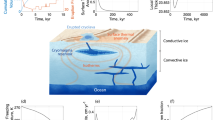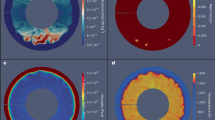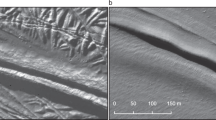Abstract
The Galileo mission measured the gravity field around Europa. The results indicated that the moon’s interior is mostly made of rock (~90 wt%). However, the level of differentiation of the deep interior is still poorly understood. We constrain the interior of Europa using Galileo gravity data and a combination of geophysical and geochemical models that connects the origin of the materials accreted in the Jupiter system with the observed gravity field. The results indicate that Europa is partially differentiated and that it probably formed primarily from CV chondrite material. We investigate this finding by coupling thermal evolution models with a detailed treatment of Fe–FeS melting. The metal–silicate differentiation temperatures (>1,600 K) are not attained if Europa formed about 4 Myr after the production of calcium aluminium inclusions. The leaching of potassium during thermal metamorphism further limits differentiation. Our results imply a cold evolution for Europa and suggest that part of water inventory of Europa was supplied by external sources, possibly by comets. These implications can be tested with the gravity data that will be acquired by Europa Clipper and JUICE.
This is a preview of subscription content, access via your institution
Access options
Access Nature and 54 other Nature Portfolio journals
Get Nature+, our best-value online-access subscription
$32.99 / 30 days
cancel any time
Subscribe to this journal
Receive 12 digital issues and online access to articles
$119.00 per year
only $9.92 per issue
Buy this article
- Purchase on SpringerLink
- Instant access to full article PDF
Prices may be subject to local taxes which are calculated during checkout




Similar content being viewed by others
Data availability
Input for the modelling and measurements are available in the published literature. The gravity measurements used in this study were retrieved from previous analyses of Galileo radio science data4,10. The mineralogical modelling and associated input are described in the Supplementary Information and in Melwani Daswani et al.17. The interior models produced in this work are available via Zenodo at https://doi.org/10.5281/zenodo.14193565 (ref. 59).
Code availability
Code relevant to the interior modelling and inversion used in this work is available upon request from the corresponding author.
References
Vance, S. D. et al. Investigating Europa’s habitability with the Europa clipper. Space Sci. Rev. 219, 81 (2023).
Dombard, A. J. & Sessa, A. M. Gravity measurements are key in addressing the habitability of a subsurface ocean in Jupiter’s moon Europa. Icarus 325, 31–38 (2019).
Běhounková, M. et al. Tidally induced magmatic pulses on the oceanic floor of Jupiter’s moon Europa. Geophys. Res. Lett. 48, e2020GL090077 (2021).
Anderson, J. D. et al. Europa’s differentiated internal structure: inferences from four Galileo encounters. Science 281, 2019–2022 (1998).
Zimmer, C., Khurana, K. K. & Kivelson, M. G. Subsurface oceans on Europa and Callisto: constraints from Galileo magnetometer observations. Icarus 147, 329–347 (2000).
Schubert, G., Sohl, F. & Hussmann, H. in Europa (eds Pappalardo, R. T. et al.) 353–367 (Univ. Arizona Press, 2009).
Sohl, F., Spohn, T., Breuer, D. & Nagel, K. Implications from Galileo observations on the interior structure and chemistry of the Galilean satellites. Icarus 157, 104–119 (2002).
Kuskov, O. L. & Kronrod, V. A. Internal structure of Europa and Callisto. Icarus 177, 550–569 (2005).
Gao, P. & Stevenson, D. K. Nonhydrostatic effects and the determination of icy satellites’ moment of inertia. Icarus 226, 1185–1191 (2013).
Gomez Casajus, L. et al. Updated Europa gravity field and interior structure from a reanalysis of Galileo tracking data. Icarus 358, 114187 (2021).
Gomez Casajus, L. et al. Gravity field of Ganymede after the Juno extended mission. Geophys. Res. Lett. 49, e2022GL099475 (2022).
Genova, A. et al. Geodetic evidence that Mercury has a solid inner core. Geophys. Res. Lett. 46, 3625–3633 (2019).
Ruesch, O. et al. Slurry extrusion on Ceres from a convective mud-bearing mantle. Nat. Geosci. 12, 505–509 (2019).
Petricca, F. et al. Characterization of icy moon hydrospheres through joint inversion of gravity and magnetic field measurements. Geophys. Res. Lett. 50, e2023GL104016 (2023).
Chen, M.-H. & Shao, Q.-M. Monte Carlo estimation of Bayesian credible and HPD intervals. J. Comput. Graph. Stat. 8, 69–92 (1999).
Trinh, K. T., Bierson, C. J. & O’Rourke, J. G. Slow evolution of Europa’s interior: metamorphic ocean origin, delayed metallic core formation, and limited seafloor volcanism. Sci. Adv. https://doi.org/10.1126/sciadv.adf3955 (2023).
Melwani Daswani, M., Vance, S. D., Mayne, M. J. & Glein, C. R. A metamorphic origin for Europa’s ocean. Geophys. Res. Lett. 48, e2021GL094143 (2021).
Melwani Daswani, M. & Castillo-Rogez, J. C. Porosity-filling metamorphic brines explain Ceres’s low mantle density. Planet. Sci. J. 3, 21 (2022).
Desch, S. J., Kalyaan, A. & Alexander, C. M. The effect of Jupiter’s formation on the distribution of refractory elements and inclusions in meteorites. Astrophys. J. 238, 11 (2018).
Connolly, J. A. D. Computation of phase equilibria by linear programming: a tool for geodynamic modeling and its application to subduction zone decarbonation. Earth Planet. Sci. Lett. 236, 524–541 (2005).
Connolly, J. A. D. The geodynamic equation of state: what and how. Geochem. Geophys. Geosyst. https://doi.org/10.1029/2009GC002540 (2009).
Anderson, J. D., Lau, E. L., Sjogren, W. L., Schubert, G. & Moore, W. B. Gravitational constraints on the internal structure of Ganymede. Nature 384, 541–543 (1996).
Kivelson, M. G. et al. Discovery of Ganymede’s magnetic field by the Galileo spacecraft. Nature 384, 537–541 (1996).
Schubert, G., Zhang, K., Kivelson, M. G. & Anderson, J. D. The magnetic field and internal structure of Ganymede. Nature 384, 544–545 (1996).
Kivelson, M. G., Khurana, K. K. & Volwerk, M. The permanent and inductive magnetic moments of Ganymede. Icarus 157, 507–522 (2002).
Anderson, J. D., Jacobson, R. A., Lau, E. L., Moore, W. B. & Schubert, G. Io’s gravity field and interior structure. J. Geophys. Res.: Planets 106, 32963–32969 (2001).
Mousis, O. et al. Early stages of Galilean moon formation in a water-depleted environment. Astrophys. J. Lett. 944, L37 (2023).
Borlina, C. S., Weiss, B. P., Bryson, J. F. & Armitage, P. J. Lifetime of the outer Solar System nebula from carbonaceous chondrites. J. Geophys. Res.: Planets 127, e2021JE007139 (2022).
Barr, A. C., Citron, R. I. & Canup, R. M. Origin of a partially differentiated Titan. Icarus 209, 858–862 (2010).
Palme, H., Lodders, K. & Jones, A. in Planets, Asteroids, Comets and The Solar System 2nd edn (ed. Davis, A. M.) 15–36 (Elsevier, 2014).
Agee, C., Li, J., Shannon, M. & Circone, S. Pressure-temperature phase diagram for the Allende meteorite. J. Geophys. Res.: Solid Earth 100, 17725–17740 (1995).
Hussmann, H. & Spohn, T. Thermal-orbital evolution of Io and Europa. Icarus 171, 391–410 (2004).
Néri, A., Guyot, F., Reynard, B. & Sotin, C. A carbonaceous chondrite and cometary origin for icy moons of Jupiter and Saturn. Earth Planet. Sci. Lett. 530, 115920 (2020).
Malhotra, R. Tidal origin of the Laplace resonance and the resurfacing of Ganymede. Icarus 94, 399–412 (1991).
Showman, A. P. & Malhotra, R. Tidal evolution into the Laplace resonance and the resurfacing of Ganymede. Icarus 127, 93–111 (1997).
Batygin, K. & Morbidelli, A. Formation of giant planet satellites. Astrophys. J. 894, 143 (2020).
Mazarico, E. et al. The Europa Clipper gravity and radio science investigation. Space Sci. Rev. 219, 30 (2023).
Kivelson, M. G. et al. The Europa Clipper magnetometer. Space Sci. Rev. 219, 48 (2023).
Khurana, K. K., Kivelson, M., Hand, K. P. & Russel, C. T. in Europa (eds Pappalardo, R. T. et al.) 571–586 (Univ. Arizona Press, 2009).
Metropolis, N., Rosenbluth, A. W., Rosenbluth, M. N., Teller, A. H. & Teller, E. Equation of state calculations by fast computing machines. J. Chem. Phys. 21, 1087–1092 (1953).
Gelman, A. & Rubin, D. B. Inference from iterative simulation using multiple sequences. Stat. Sci.https://doi.org/10.1214/ss/1177011136 (1992).
Marshall, S. J. The Cryosphere (Princeton Univ. Press, 2011).
Sotin, C. & Tobie, G. Internal structure and dynamics of the large icy satellites. Comptes Rendus Phys. 5, 769–780 (2004).
Journaux, B. et al. Large ocean worlds with high-pressure ices. Space Sci. Rev. https://doi.org/10.1007/s11214-019-0633-7 (2020).
Castillo-Rogez, J. et al. Iapetus’ geophysics: rotation rate, shape, and equatorial ridge. Icarus 190, 179–202 (2007).
Castillo-Rogez, J. C. & Lunine, J. I. Evolution of Titan’s rocky core constrained by Cassini observations. Geophys. Res. Lett. https://doi.org/10.1029/2010GL044398 (2010).
Soder, C. & Romer, R. Post-collisional potassic-ultrapotassic magmatism of the Variscan orogen: implications for mantle metasomatism during continental subduction. J. Petrol. 59, 1007–1034 (2018).
Tobie, G., Mocquet, A. & Sotin, C. Tidal dissipation within large icy satellites: applications to Europa and Titan. Icarus 177, 534–549 (2005).
Castillo-Rogez, J. C., Efroimsky, M. & Lainey, V. The tidal history of Iapetus: spin dynamics in the light of a refined dissipation model. J. Geophys. Res.: Planets https://doi.org/10.1029/2010JE003664 (2011).
Malissa, H., Hermann, F., Kluger, P. & Kiesl, W. Chemical and microprobe investigations of the Allende-meteorite. Microchim. Acta 60, 434–450 (1972).
Bland, P. A., Cressey, G. & Menzies, O. N. Modal mineralogy of carbonaceous chondrites by X-ray diffraction and Mössbauer spectroscopy. Meteorit. Planet. Sci. 39, 3–16 (2004).
Howard, K., Benedix, G., Bland, P. & Cressey, G. Modal mineralogy of CV3 chondrites by X-ray diffraction (PSD-XRD). Geochim. Cosmochim. Acta 74, 5084–5097 (2010).
Brearley, A. J. Origin of graphitic carbon and pentlandite in matrix olivines in the Allende meteorite. Science 285, 1380–1382 (1999).
Larimer, J. W. & Anders, E. Chemical fractionations in meteorites. II. Abundance patterns and their interpretation. Geochim. Cosmochim. Acta 31, 1239–1270 (1967).
Bagdassarov, N., Golabek, G., Solferino, G. & Schmidt, M. Constraints on the Fe-S melt connectivity in mantle silicates from electrical impedance measurements. Phys. Earth Planet. Inter. 177, 139–146 (2009).
Solferino, G. F. D., Thomson, P.-R. & Hier-Majumder, S. Pore network modeling of core forming melts in planetesimals. Front. Earth Sci. https://doi.org/10.3389/feart.2020.00339 (2020).
Néri, A., Guignard, J., Monnereau, M., Toplis, M. & Quitté, G. Metal segregation in planetesimals: constraints from experimentally determined interfacial energies. Earth Planet. Sci. Lett. 518, 40–52 (2019).
Lodders, K. & Fegley, B. The Planetary Scientist’s Companion (Oxford Univ. Press, 1998).
Petricca, F., Castillo-Rogez, J., Genova, A., Styczinski, M., Cochrane, C. & Vance, S.. Supplementary material for Petricca et al. 2024 ‘Partial differentiation of Europa and implications for the origin of materials in the Jupiter system’. Zenodo https://doi.org/10.5281/zenodo.14193565 (2024).
Acknowledgements
We thank F. Nimmo (University of California Santa Cruz), C. Glein (Southwest Research Institute), O. Mousis (Aix-Marseille Université), H. Hussmann (DLR), R. Malhotra (University of Arizona) and the Europa Clipper Gravity/Radio Science investigation team for fruitful discussions and suggestions that substantially improved the manuscript. F.P. and A.G. acknowledge funding from the Italian Space Agency (Contract 2021-19-HH.0). M.M.D. was supported by NASA’s Habitable Worlds programme (Solicitation NNH18ZDA001N-HW, Proposal No. 18-HW18_2-0111). This work was partially supported by 22-PSIE22_2-0024 and by NASA’s Europa Clipper mission. Parts of this work were carried out at the Jet Propulsion Laboratory, California Institute of Technology, under a contract with NASA (80NM0018D0004). M.J.S. was supported by an appointment to the NASA Postdoctoral Program at the Jet Propulsion Laboratory, California Institute of Technology, administered by Oak Ridge Associated Universities under a contract with NASA (80HQTR21CA005).
Author information
Authors and Affiliations
Contributions
F.P., J.C.C.-R. and A.G. conceived the initial study. F.P. designed and performed the interior structure inversion and analysis. J.C.C.-R. contributed the thermal evolution modelling and analysis. M.M.D. provided the mineralogy and geochemical modelling. All authors contributed to the discussion and interpretation of the results. F.P. and J.C.C.-R. wrote the first draft of the paper. All authors contributed to the revisions of the paper.
Corresponding author
Ethics declarations
Competing interests
The authors declare no competing interests.
Peer review
Peer review information
Nature Astronomy thanks Stefano Bertone and the other, anonymous, reviewer(s) for their contribution to the peer review of this work.
Additional information
Publisher’s note Springer Nature remains neutral with regard to jurisdictional claims in published maps and institutional affiliations.
Supplementary information
Supplementary Information
Supplementary Figs. 1–11, Sections 1–6 and Table 1.
Rights and permissions
Springer Nature or its licensor (e.g. a society or other partner) holds exclusive rights to this article under a publishing agreement with the author(s) or other rightsholder(s); author self-archiving of the accepted manuscript version of this article is solely governed by the terms of such publishing agreement and applicable law.
About this article
Cite this article
Petricca, F., Castillo-Rogez, J.C., Genova, A. et al. Partial differentiation of Europa and implications for the origin of materials in the Jupiter system. Nat Astron 9, 501–511 (2025). https://doi.org/10.1038/s41550-024-02469-4
Received:
Accepted:
Published:
Issue date:
DOI: https://doi.org/10.1038/s41550-024-02469-4
This article is cited by
-
Europa’s silent seafloor
Nature Astronomy (2025)
-
What lies beneath Europa’s icy surface? Perhaps a heart of metal
Nature (2025)



